
Autorun MAX! |

|

|

|

|
||
Autorun MAX! |

|

|

|

|

|
This application can be downloaded at: http://www.autorun.com . The test was done with version 2.1.0.
The menu application creates an EXE (autorun.exe) file. This file (the menu application) is on the CD or in the download link and it is not protected (don't import it in the Multimedia Protector database).
Start Autorun MAX!.
You have to add all files which should be included in the Autorun MAX! project. Select the menu Project, File Layout. In the upper part of the screen open the Deploy folder, select all files and add the files to the docs folder.
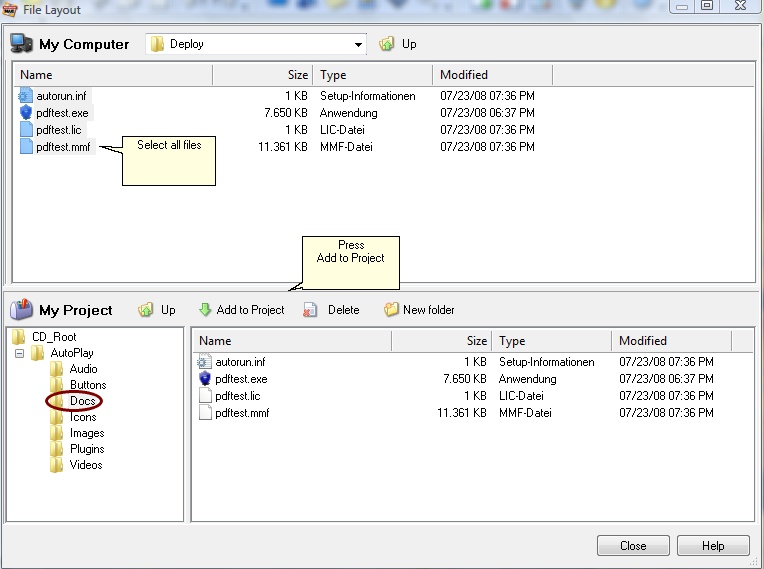
Now create your menu and add a button for each file you want to start, e.g. a button with Tutorial 1, Tutorial 2 etc. Then right click on the button and select Properties.
Select: Action to run: Run Program. In the line File to run add the path and the name of the Multimedia Player.exe file from the Deploy folder. In the line Command line arguments add the command to load a flash file or PDF file. See chapter Start a specific file inside the database to get all details for this command.
In the screenshot below, the file (Player) mycourse.exe is started and loads the file lesson1.swf. You have to set the Working folder to the same path where the Multimedia Player.exe is located.
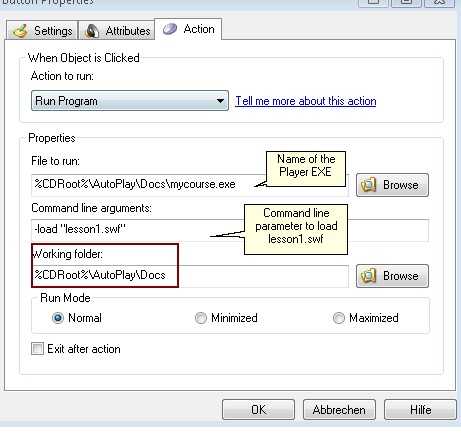
The sample below starts the player with a different database. This feature can be used if you split the project into several databases.
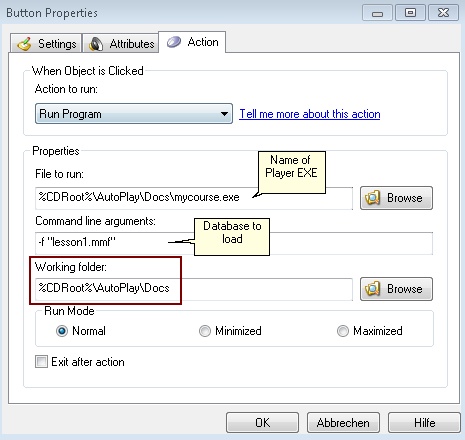
To select the working folder, click on the Browse button and select the Docs folder
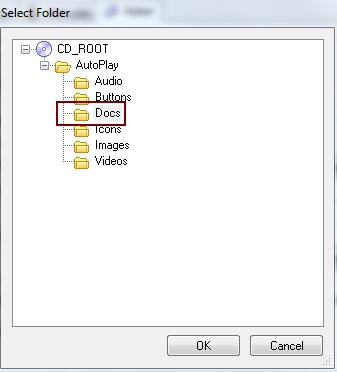
![]() If you don't specify a command line, the main database (same name like the Multimedia Player) is started and the file, which is defined as start file, is loaded.
If you don't specify a command line, the main database (same name like the Multimedia Player) is started and the file, which is defined as start file, is loaded.
In the menu, select Publish, Build. Then select Hard drive folder to test the project.
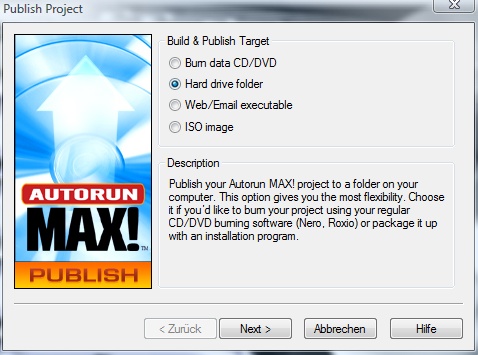
A good idea is to create a new folder, e.g. cd-project training 1
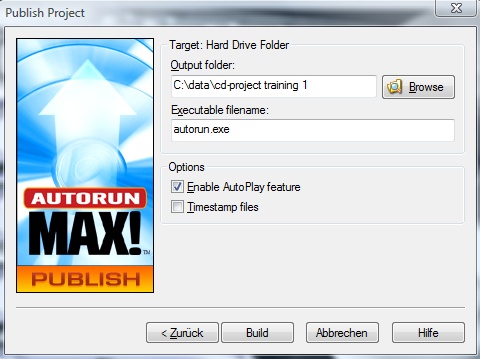
All your files are now copied from the Deploy folder to this new CD folder. Click on Autorun.exe to test everything.
If you have done all tests, you could directly burn a CD. The option "Web / EMail executable" is only working in combination with the Installation Manager (see chapter below). Without the Installation Manager, Autorun MAX! would extract during every program start all files again and overwrite the existing license information.
![]() If you make any changes in the Multimedia Protector project, you have to rebuild the CD with Autorun MAX!
If you make any changes in the Multimedia Protector project, you have to rebuild the CD with Autorun MAX!
List of all start options for the player
If the complete CD content should be copied to the hard disk of the user, you can use the Installation Manager of Multimedia Protector. Copy the file setup.exe and setup.ini to the installation directory created by Autorun Max!.

The general settings are described in the chapter Installation Manager, configuration file Setup.ini. There are special settings required as all subfolders have to be copied. After the installation and also when clicking on the desktop icon, the menu and not the Multimedia Player has to be started.
Find below all differing settings.
[Setup]
AppName=My Program
AppVersion=3.0
AppPublisher=Universal Software
DefaultDirName=My Program
DefaultGroupName=My Program
[Files]
BinFolder=\autoplay\docs
Exe-Start-Application=Autorun.exe
exe-Filename=\autoplay\docs\mycourse.exe
mmf-Filename=\autoplay\docs\mycourse.mmf
lic-Filename=\autoplay\docs\mycourse.lic
ico-Filename=\autoplay\docs\mycourse.ico
readme-ces=
readme-dan=
readme-deu=
readme-dut=
readme-enu=
readme-esp=
readme-fra=
readme-ita=
readme-nor=
readme-por=
additional1=autoplay\*
additional2=autorun.exe
additional3=autorun.inf
additional4=
additional5=
additional6=
additional7=
additional8=
additional9=
additional10=
additional11=
additional12=
additional13=
additional14=
additional15=
additional16=
additional17=
additional18=
additional19=
additional20=
additionalfolder1=autoplay
additionalfolder2=
additionalfolder3=
additionalfolder4=
additionalfolder5=
additionalfolder6=
additionalfolder7=
additionalfolder8=
additionalfolder9=
additionalfolder10=
additionalfolder11=
additionalfolder12=
additionalfolder13=
additionalfolder14=
additionalfolder15=
additionalfolder16=
additionalfolder17=
additionalfolder18=
additionalfolder19=
additionalfolder20=
[Options]
InstallPDFViewer=false
OverwriteLicenseFile=true
RunPlayerAfterInstall=false
RunPlayerAfterInstallNetwork=true
RunBeforeInstall=
RunBeforeInstallNetwork=
RunAfterInstall=autorun.exe
RunAfterInstallNetwork=
[USB]
use-usb=true
[ProgManGroup]
ShowLicenseInfo=true
ShowLicenseInfoNetwork=
ShowReadmeFile=false
DBFileName01=
EmbeddedDBFileDesc01=
EmbeddedDBFileName01=
[Uninstall]
AppComments=(C) 2009 Universal Software, Inc.
AppContact=office@universal-soft.com
AppPublisher=Universal Software, Inc
AppPublisherURL=http://www.universal-soft.com
AppSupportURL=http://www.universal-soft.com/support
AppUpdatesURL=http://www.universal-soft.com/downloads
To install a download or a CD version to the hard disk including adding a desktop icon or program manager group entry, use the Installation Manager.
In case you want to deliver one EXE file as a download version see chapter: How to create a download version in EXE format?
Otherwise just ZIP all files.
![]() Also see: How can I share my files using a download link?
Also see: How can I share my files using a download link?
See also
Start a specific file inside the database
Split project into several databases
All command line options
Additional Menus